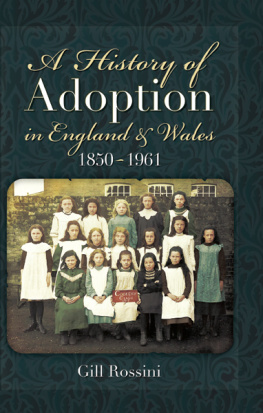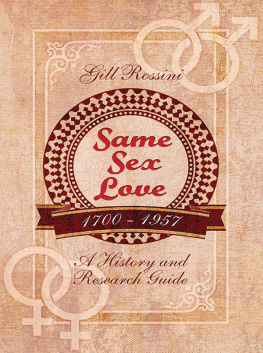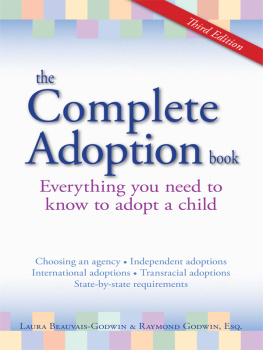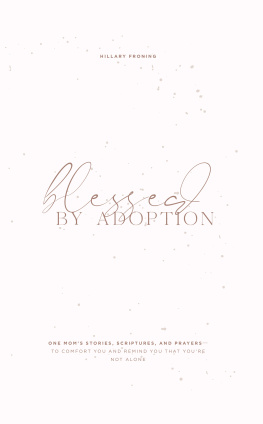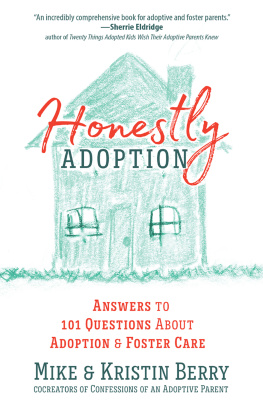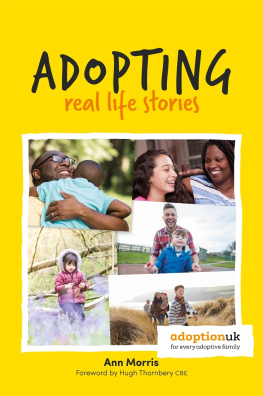This book is dedicated to
Mrs E.P. Taylor
to honour her boundless courage in
overwhelming circumstances
and to celebrate her infinite love for her twins.
First published in Great Britain in 2014 by
PEN AND SWORD FAMILY HISTORY
an imprint of
Pen and Sword Books Ltd
47 Church Street
Barnsley
South Yorkshire S70 2AS
Copyright Gill Rossini, 2014
ISBN: 978 1 78159 395 0
EPUB ISBN: 978 1 47384 644 9
PRC ISBN: 978 1 47384 633 3
The right of Gill Rossini to be identified
as the author of this work has been asserted by her in accordance
with the Copyright, Designs and Patents Act 1988.
A CIP record for this book is available from the British Library
All rights reserved. No part of this book may be reproduced or
transmitted in any form or by any means, electronic or
mechanical including photocopying, recording or
by any information storage and retrieval system, without
permission from the Publisher in writing.
Printed and bound in England
by CPI Group (UK) Ltd, Croydon, CR0 4YY
Typeset in Times New Roman by
CHIC GRAPHICS
Pen & Sword Books Ltd incorporates the imprints of Pen & Sword
Archaeology, Atlas, Aviation, Battleground, Discovery,
Family History, History, Maritime, Military, Naval, Politics, Railways,
Select, Social History, Transport, True Crime, and Claymore Press,
Frontline Books, Leo Cooper, Praetorian Press, Remember When,
Seaforth Publishing and Wharncliffe.
For a complete list of Pen and Sword titles please contact
Pen and Sword Books Limited
47 Church Street, Barnsley, South Yorkshire, S70 2AS, England
E-mail:
Website: www.pen-and-sword.co.uk
Contents
Acknowledgements
My grateful thanks go firstly to Pen and Swords History Imprint editor Jennifer Newby, whose patient, good natured and wise guidance has been beyond value as this book has progressed, and who has put up with my endless questions over its illustrations with immense good humour. Also a huge thank you to Amanda Kay for her patient and highly professional editorial guidance, without which this book would have been the poorer.
The grant given to me by the Authors Foundation has been a boon in helping me to purchase materials necessary for my research; my grateful thanks to them.
Thank you to all the staff in archive departments and libraries who have helped identify sources for the history of adoption. I have the utmost respect and gratitude for your professional guidance.
I have had the ultimate sounding board for my ideas and theories the many hundreds of family history students who have endured my teaching over more than 20 years, but in particular, the students from North and Mid Wales and Greater Manchester, who over the past seven years, have been my lively, intelligent and completely constructive collective muse. You have been more valuable than I can say. Special thanks go to Viv, Ruth, Gaynor, Marianna and Pam for their kindly interest and practical support.
To my darling partner Gill, my everlasting gratitude and love for tolerating the piles of paper, files, books, monologues and ponderings generated by this project, and for sharing your own experiences with me.
Finally, my deepest respect and love to Mum and her twins, for all they have gone through, and for sharing it with me. Thank you for giving me the gift of your stories.
A Note Regarding Confidentiality
A need for confidentiality even secrecy has always been present when it comes to adoption until very recently, and even now it is an issue that must be taken into account. This book is no exception in respecting that need. In stories recounted by living persons or in which living persons are mentioned, all names and locations have been changed to respect and protect the individuals concerned.
A Note Regarding Terminology
Apart from those with a single interest in adoption and its history, it is sincerely hoped that this book will appeal to a wide range of readers family, social and local historians, of course, but also those with an interest in the history of childhood, child educators, and students of child development. I have tried not to assume any prior in-depth knowledge of the terminology or chronology of this period, especially regarding the issues surrounding the welfare of children. To help clarify what the narrative has not made evident, I have added a glossary of the key terms used in the text.
Illustrations
CHAPTER 1
Introduction and Background
Adoption is one of the most emotive subjects in social history, and in family history in particular. Express an interest in adoption especially those in past generations and the majority of family historians have an adoption story to tell you about from their own genealogies.
Adoption is only one event in a persons life, and yet it can resonate not only throughout that persons life, but right through a family history too. One of the reasons it is such a compelling subject is perhaps its inherent and sometimes frustrating mystery. England and Wales were late in legislating for formal adoptions compared to other countries. Before that point there was a vast confusion of makeshift solutions to the perennial problem of the unwanted child or baby, especially those born out of wedlock.
The shame of being an unmarried mother, or of having a single mother in the family, led to a bewildering number of ways for dealing with these misfits, many of which involved the family closing ranks, dealing with the matter secretly, and never talking about it again. However, families being what they are, eventually someone usually breaks ranks and an ill-chosen, disingenuous or malicious remark could blow the cover of a secret that has been kept close for generations. All family historians love intrigue of this kind, but the problems of solving the adoption mysteries in a family tree can seem insurmountable. Even after 1926 the year adoptions were legally formalised in England and Wales the official secrecy around an adoption deters most enquirers who are not the adoptee themselves from tackling the research.
What Exactly is Adoption?
In order to explore this topic, a definition of adoption must be arrived at, but this is not as simple as it first appears. In the twenty-first century, we tend to think of adoption in a narrow sense, as the taking into ones family through a legal procedure, the child of another person or family. It is a very small definition for an event of life-changing and highly emotional significance. The definition can be widened. For example, it could be said that whenever a person or an organisation is in loco parentis for any length of time, they are in an adoptive situation, or at the very least, are foster parents. This would then widen the definition to include the carers of evacuee children in World War Two, as well as the poor relief authorities caring for children in the nineteenth century and early twentieth century.
If one accepts organisations as adopters, childrens homes and orphanages must then be added. The definition of adoption would also apply to family members who informally took on a relatives child, although they would be unlikely to see this as adoption, more as helping out the parent concerned out of familial loyalty. In 1937, the Horsbrugh Committee Report (see ) described adoption as follows:
The essence of an adoption, whether legalised or de facto, seems to us to lie in the creation of an artificial family relationship analogous to that of parent and child which is accepted by all parties as permanent. The child is absorbed into the family of the adopter and is treated as if it were their own natural child.
There is a word of warning to be borne in mind with regard to this statement, for not all natural children are treated with love, nurtured, and guided as they should be. Adoption does not always have a happy ending because the lives of children are variable whatever their beginnings, and it includes the whole spectrum of stories, just like those from any other walk of life.
Next page
